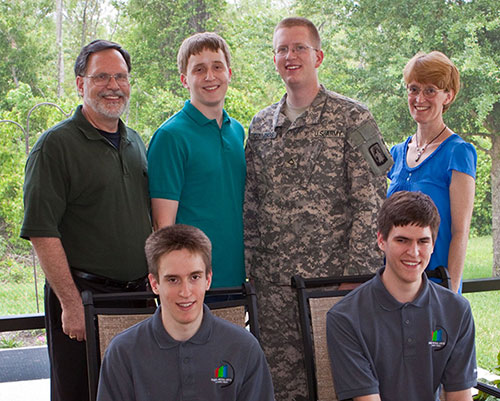Siblings Helping Siblings
By Sara Erling
NACD Evaluator
NACD works with cream of the crop parents–parents who are willing to do whatever they can do to help their child succeed. While being able to do an entire program, as well as all your other duties that fall under the job of parent, sounds fairly easy in theory, we all know that reality is a different story. The more help you can have to help implement your child’s NACD program, the better. Bob Doman said in a seminar several years ago to look at yourselves as managers of your child’s program, not as the only person that can implement it. Some of the best people to implement program with our kids are those individuals who live under the same roof. When siblings help siblings, they can accomplish much. First of all, children and teenagers can provide great intensity. Secondly, by having your other children help with the implementation of program, chances are you will be able to complete more program than you would have alone. Finally, while your child on program is reaping the benefits of additional program with intensity, the siblings (both younger and older) are getting benefits as well. Not only can they become accelerated in their development, but they can also learn about responsibility and hope— that nothing is impossible and through hard work, caring, and diligence, the sky is the limit in what they put their mind to.
Frequency, Intensity, and Duration: You hear those words from us over and over. What is the most important of the three? INTENSITY! The intensity of the input is what is going to determine whether it sticks or not. Kids have such a great way of creating intensity with program. They know how to play, and they don’t have any preconceived notions of their sibling’s abilities. The following clip is a perfect example of a sibling helping a sibling with a processing activity. In this video little Ellie is helping big sister Samantha do the ball tower activity:
It doesn’t look like work, does it? It was a fun game they were playing. Our kids on program love their siblings. They light up when their brother or sister enters the room. That is intensity. Most anyone is capable of implementing program activities. A smart 4 year old can do sequencing. A child or teenager can be taught how to implement pleoptics. And many of our kids can do something that is hard for us to do all the time – keep our kids engaged! Playing ball or video games, interactive play, or teaching a computer game are all things that siblings can do to keep their brother or sister busy and engaged. Take advantage of their help!
You have already discovered that getting your child’s entire program done can be difficult. Life is full and busy, and finding the time to provide our kids with the input necessary to move forward can be tough. Enlisting your other children to help implement program may be a critical step toward making the progress you desire. Many times we recommend that you look at your family’s day and week—especially the times when the other kids are home. To maximize the amount of program you get done in the day, create a 15-minute time structure. With a fifteen-minute time structure, we recommend that you break up the program activities into fifteen-minute segments. Be sure to count all your frequencies within those periods. One way to make it easy is to have an index card system. With this method, write down fifteen minutes worth of program activities on an index card. Have two separate piles…one ‘to do’ and one ‘complete’ pile. As you, your spouse, or the siblings do a card with the child on program, that card goes into the complete pile. When having your other children help implement program, it is very important that everyone knows what the goals are. For example, with processing activities, the goal could be to get the child to sequence three. Or if the goal is to get the child crawling on their belly, a goal in each session could be to help the child crawl 3 feet to a goal. If keeping the child engaged is a goal, the fifteen minutes could be dedicated to playing ball with the child or playing a Wii game. Having weekly, monthly, and quarterly goals is essential for an NACD family.
Finally, if you were thinking about how to get your other children to help you, I would first encourage you to make these things non-negotiable with your children. Just like jobs that they are required to do in the house, it is simply another role they play as a member of the family. Sometimes it is necessary to have the talk with your more mature child that helping their sibling walk and talk and think will help all of them, and what an amazing opportunity to know that they played a huge role in that process! Our siblings who help their brother or sister change and improve their function learn invaluable life lessons. They learn not to set limits. They learn that anything is possible if you work hard at something.
For those of you who do not have multiple children, these same ideas can apply to hiring someone to come in to help with program. It doesn’t take a licensed professional to do program. Volunteers from church, your babysitter, the 13 year old across the street, can all help. Even just a couple oh hours each week can be enough to dramatically improve intensity, help get more program done, and help you not go crazy! 2009 is almost over. We encourage you to sit with your family and discuss what can be done to make 2010 a more productive and life changing year.




